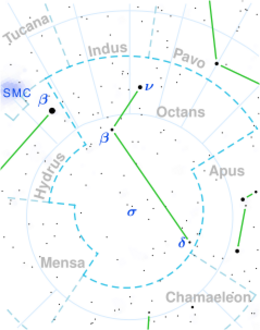Astronomy:HD 169904
| Observation data Epoch J2000.0 Equinox (celestial coordinates) | |
|---|---|
| Constellation | Octans |
| Right ascension | 18h 42m 14.42015s[1] |
| Declination | −81° 48′ 29.2064″[1] |
| Apparent magnitude (V) | 6.26±0.01[2] |
| Characteristics | |
| Evolutionary stage | main sequence star[3] |
| Spectral type | B8 V[4] |
| U−B color index | −0.37[5] |
| B−V color index | −0.13[5] |
| Variable type | suspected[6] |
| Astrometry | |
| Radial velocity (Rv) | −6.0±4.3[7] km/s |
| Proper motion (μ) | RA: +13.838[1] mas/yr Dec.: −16.605[1] mas/yr |
| Parallax (π) | 6.7598 ± 0.0413[1] mas |
| Distance | 482 ± 3 ly (147.9 ± 0.9 pc) |
| Absolute magnitude (MV) | +0.19[8] |
| Details | |
| Mass | 3.25±0.06[3] M☉ |
| Radius | 2.42±0.12[9] R☉ |
| Luminosity | 141+14−13[3] L☉ |
| Surface gravity (log g) | 4.20[10] cgs |
| Temperature | 13,622[11] K |
| Metallicity [Fe/H] | −0.18[12] dex |
| Rotational velocity (v sin i) | 123[13] km/s |
| Other designations | |
| Database references | |
| SIMBAD | data |
HD 169904 (HR 6912; 35 G. Octantis) is a solitary star located in the southern circumpolar constellation Octans. It has an apparent magnitude of 6.26,[2] placing it near the limit for naked eye visibility, even under ideal conditions. Gaia DR3 parallax measurements imply a distance of 482 light-years[1] and it is currently drifting closer with a somewhat constrained radial velocity of −6.0 km/s.[7] At its current distance, HD 169904's brightness is diminished by 0.24 magnitudes due to interstellar extinction[15] and it has an absolute magnitude of +0.19.[8]
HD 169904 has a stellar classification of B8 V,[4] indicating that it is an ordinary B-type main-sequence star that is generating energy via hydrogen fusion at its core. It has 3.25 times the mass of the Sun[3] and 2.42 times the radius of the Sun.[9] It radiates 141 times the luminosity of the Sun[3] from its photosphere at an effective temperature of 13,622 K,[11] giving it a blue-white hue when viewed in the night sky. HD 169904 is metal deficient with an iron abundance of [Fe/H] = −0.18 or 66.1% of the Sun's,[12] and it spins rapidly with a projected rotational velocity of 123 km/s.[13] HD 169904 is estimated to have completed 47.5% of its main sequence lifetime.[3]
The object was listed as a suspected variable star based on photometric observations,[6] but subsequent observations have not confirmed this.[16]
References
- ↑ 1.0 1.1 1.2 1.3 1.4 Vallenari, A. et al. (2022). "Gaia Data Release 3. Summary of the content and survey properties". Astronomy & Astrophysics. doi:10.1051/0004-6361/202243940 Gaia DR3 record for this source at VizieR.
- ↑ 2.0 2.1 Høg, E.; Fabricius, C.; Makarov, V. V.; Urban, S.; Corbin, T.; Wycoff, G.; Bastian, U.; Schwekendiek, P. et al. (March 2000). "The Tycho-2 catalogue of the 2.5 million brightest stars". Astronomy and Astrophysics 355: L27–L30. ISSN 0004-6361. Bibcode: 2000A&A...355L..27H.
- ↑ 3.0 3.1 3.2 3.3 3.4 3.5 Zorec, J.; Royer, F. (January 2012). "Rotational velocities of A-type stars IV: Evolution of rotational velocities". Astronomy & Astrophysics 537: A120. doi:10.1051/0004-6361/201117691. ISSN 0004-6361. Bibcode: 2012A&A...537A.120Z.
- ↑ 4.0 4.1 Houk, N.; Cowley, A. P. (1975). University of Michigan Catalogue of two-dimensional spectral types for the HD stars: Declinations −90° to −53°. 1. Bibcode: 1975mcts.book.....H.
- ↑ 5.0 5.1 Johnson, H. L.; Mitchell, R. I.; Iriarte, B.; Wisniewski, W. Z. (1966). "UBVRIJKL Photometry of the Bright Stars". Communications of the Lunar and Planetary Laboratory 4: 99–110. Bibcode: 1966CoLPL...4...99J.
- ↑ 6.0 6.1 Grønbech, B.; Olsen, E. H. (July 1976). "Four-color uvby photometry for bright O to G0 type stars south of declination +10 .". Astronomy and Astrophysics Supplement Series 25: 213–270. ISSN 0365-0138. Bibcode: 1976A&AS...25..213G.
- ↑ 7.0 7.1 Gontcharov, G. A. (November 2006). "Pulkovo Compilation of Radial Velocities for 35,495 Hipparcos stars in a common system". Astronomy Letters 32 (11): 759–771. doi:10.1134/S1063773706110065. ISSN 1063-7737. Bibcode: 2006AstL...32..759G.
- ↑ 8.0 8.1 Anderson, E.; Francis, Ch. (May 2012). "XHIP: An extended hipparcos compilation". Astronomy Letters 38 (5): 331–346. doi:10.1134/S1063773712050015. ISSN 1063-7737. Bibcode: 2012AstL...38..331A.
- ↑ 9.0 9.1 Kervella, P.; Thévenin, F.; Di Folco, E.; Ségransan, D. (April 8, 2004). "The angular sizes of dwarf stars and subgiants: Surface brightness relations calibrated by interferometry". Astronomy & Astrophysics 426 (1): 297–307. doi:10.1051/0004-6361:20035930. ISSN 0004-6361. Bibcode: 2004A&A...426..297K.
- ↑ McDonald, I.; Zijlstra, A. A.; Watson, R. A. (15 June 2017). "Fundamental parameters and infrared excesses of Tycho–Gaia stars". Monthly Notices of the Royal Astronomical Society 471 (1): 770–791. doi:10.1093/mnras/stx1433. ISSN 0035-8711. Bibcode: 2017MNRAS.471..770M.
- ↑ 11.0 11.1 Philip, A. G. D.; Egret, D. (May 1980). "An analysis of the Hauck-Mermillod catalogue of homogeneous four-color data. II.". Astronomy and Astrophysics Supplement Series 40: 199–205. ISSN 0365-0138. Bibcode: 1980A&AS...40..199P.
- ↑ 12.0 12.1 Anders, F. et al. (February 2022). "Photo-astrometric distances, extinctions, and astrophysical parameters for Gaia EDR3 stars brighter than G = 18.5". Astronomy & Astrophysics 658: A91. doi:10.1051/0004-6361/202142369. ISSN 0004-6361. Bibcode: 2022A&A...658A..91A.
- ↑ 13.0 13.1 Levato, Hugo; Grosso, Mónica (June 2004). "New Projected Rotational Velocities of All Southern B-type Stars of the Bright Star Catalogue". Symposium - International Astronomical Union 215: 51–52. doi:10.1017/S0074180900195191. ISSN 0074-1809. Bibcode: 2004IAUS..215...51L.
- ↑ "HD 169904". SIMBAD. Centre de données astronomiques de Strasbourg. http://simbad.u-strasbg.fr/simbad/sim-basic?Ident=HD+169904.
- ↑ Gontcharov, George A.; Mosenkov, Aleksandr V. (28 September 2017). "Verifying reddening and extinction for Gaia DR1 TGAS main sequence stars". Monthly Notices of the Royal Astronomical Society 472 (4): 3805–3820. doi:10.1093/mnras/stx2219. ISSN 0035-8711. Bibcode: 2017MNRAS.472.3805G.
- ↑ Samus, N. N.; Durlevich, O. V. (November 2004). "VizieR Online Data Catalog: Combined General Catalogue of Variable Stars (Samus+ 2004)". VizieR Online Data Catalog: II/250. Bibcode: 2004yCat.2250....0S.
<ref> tag with name "Gould1879" defined in <references> is not used in prior text.
 |


